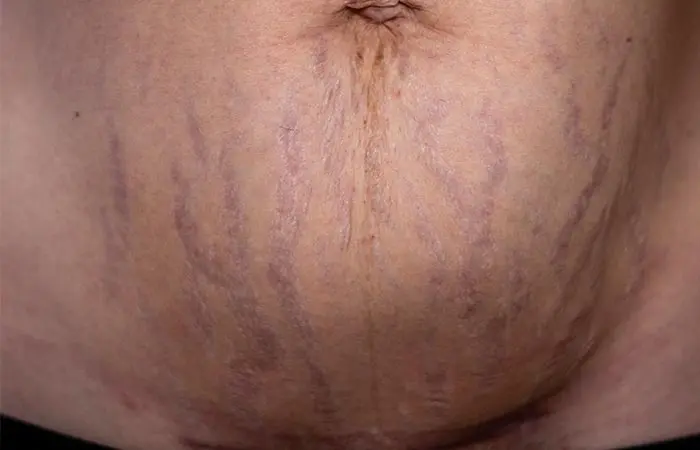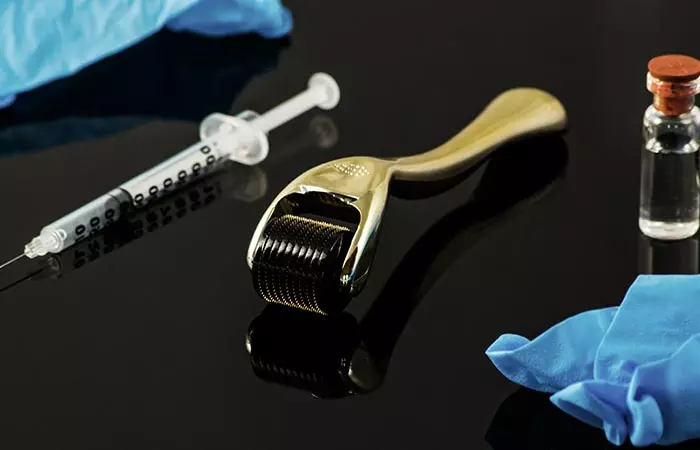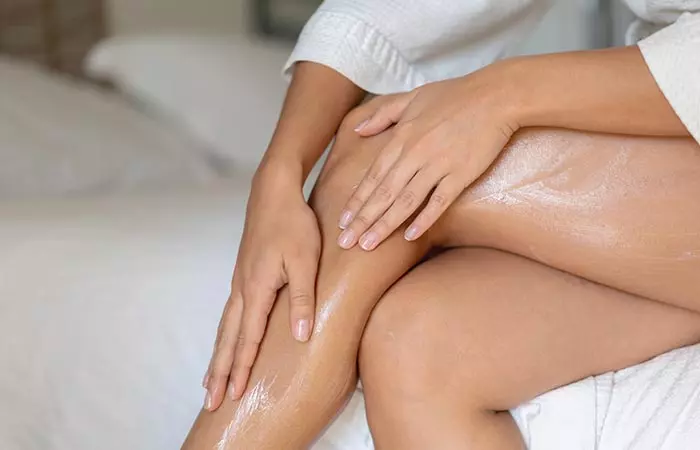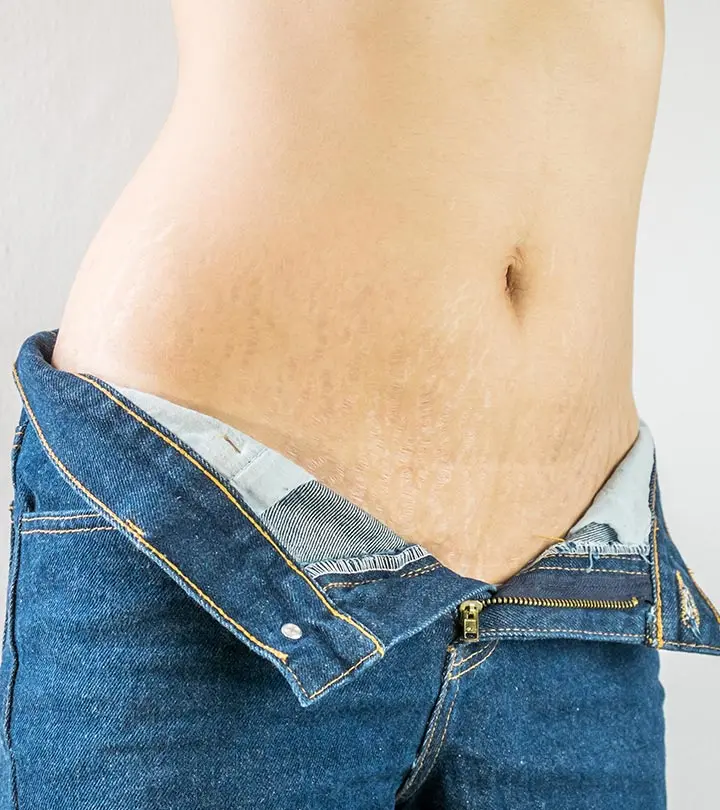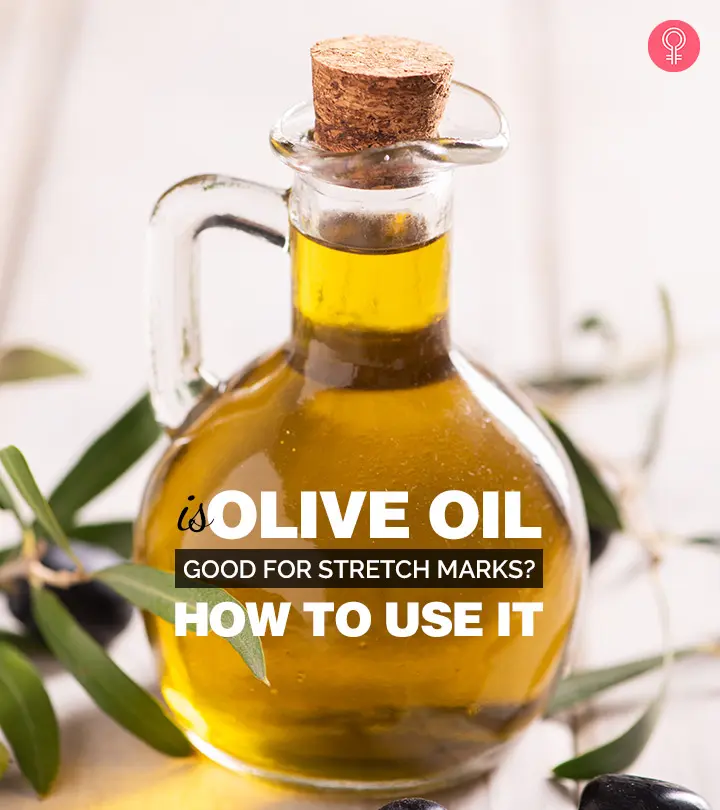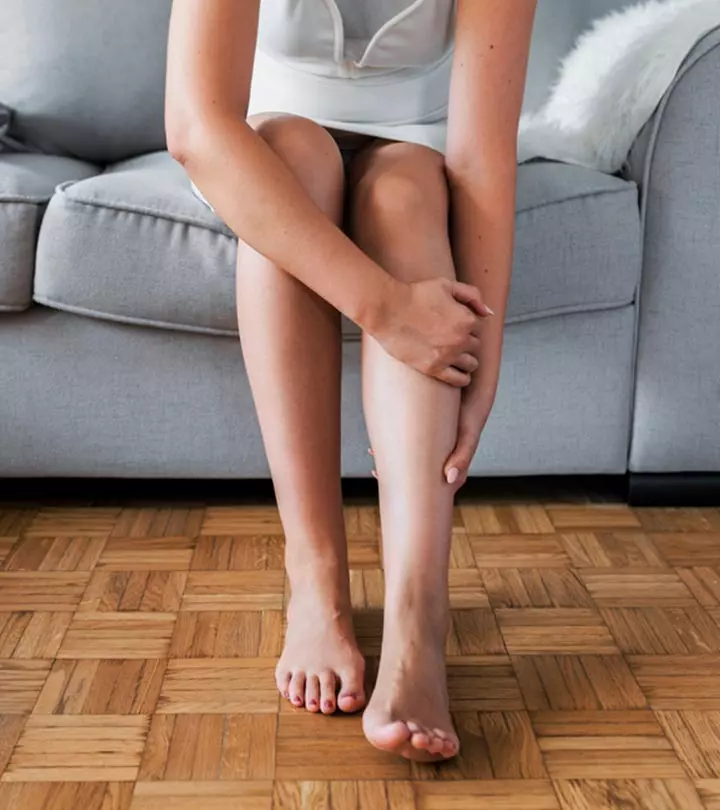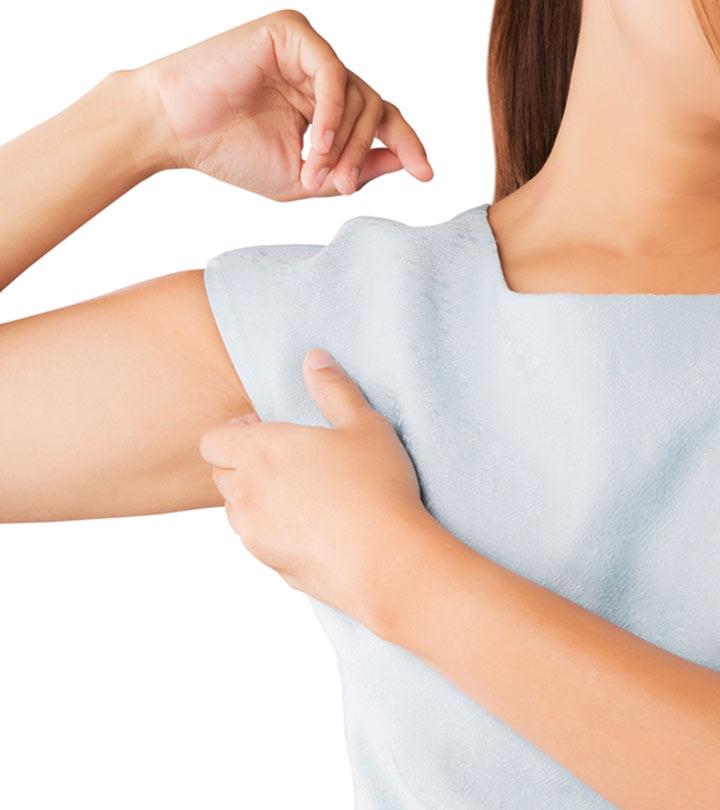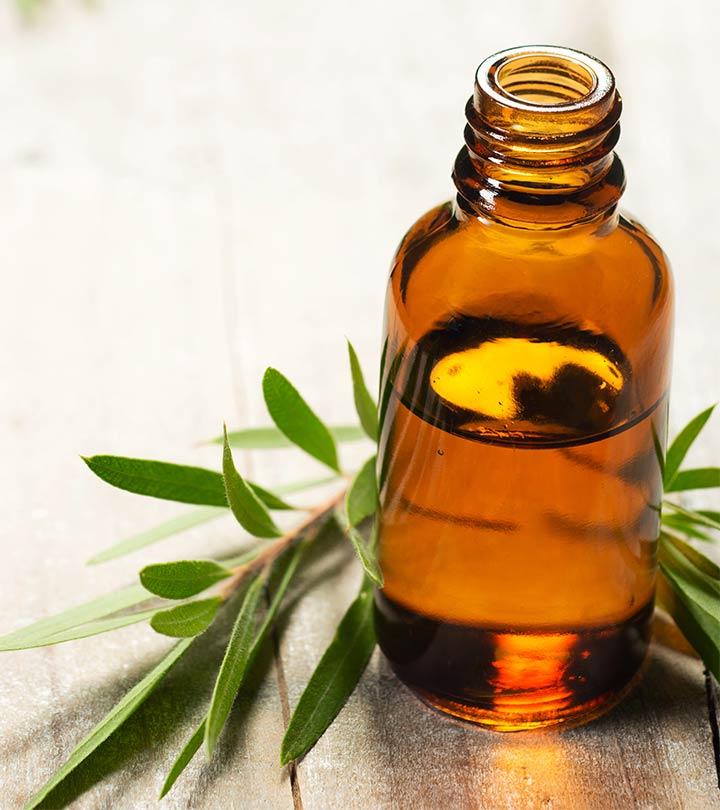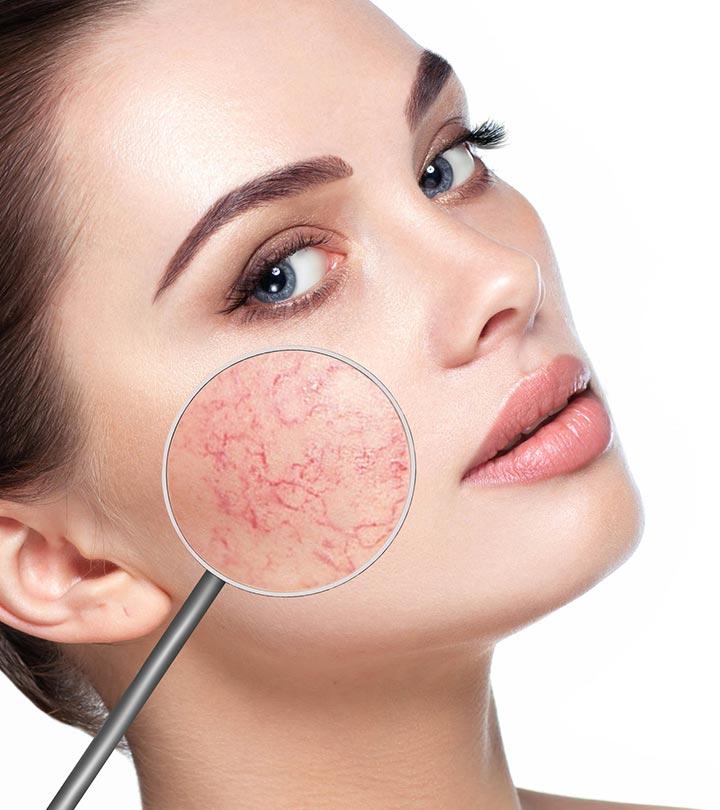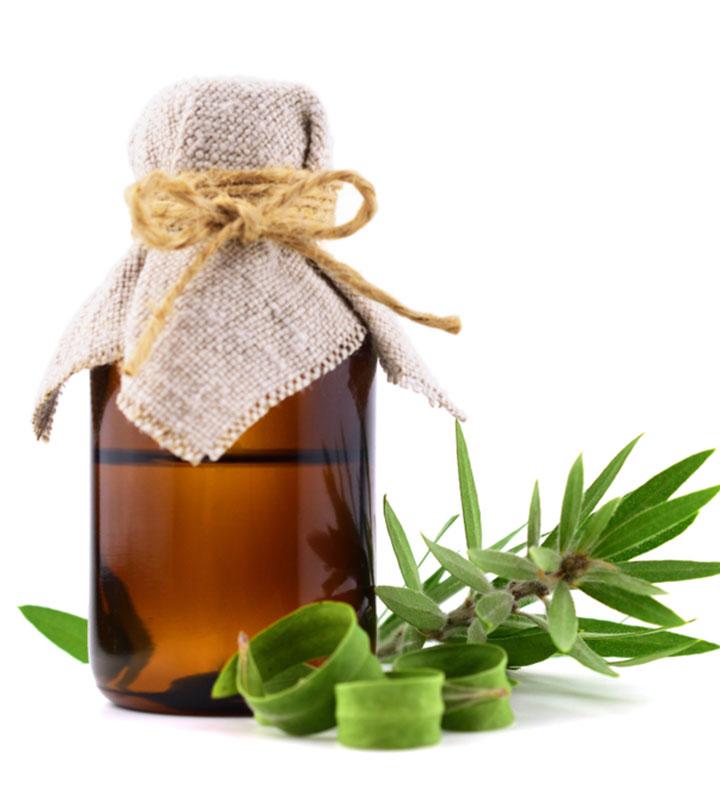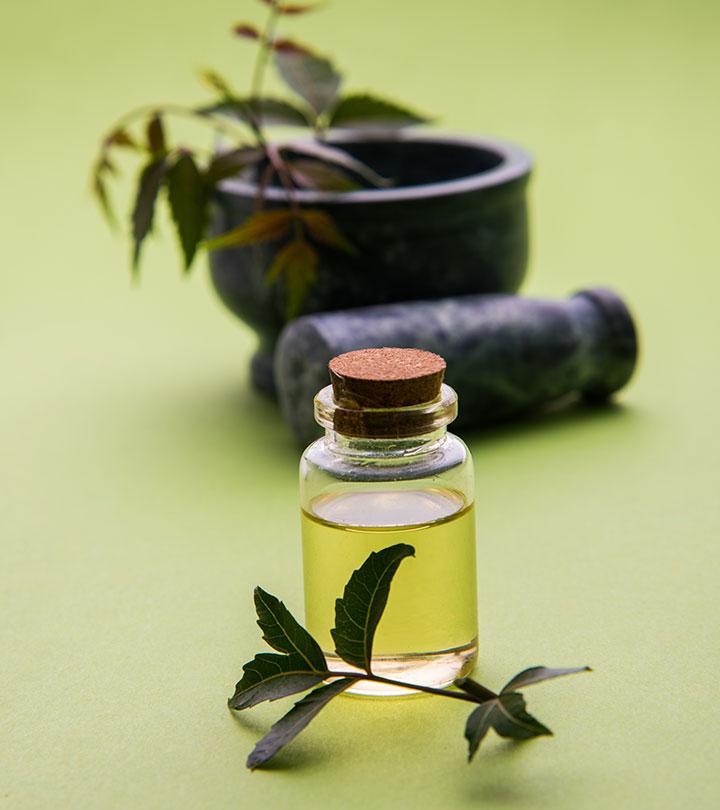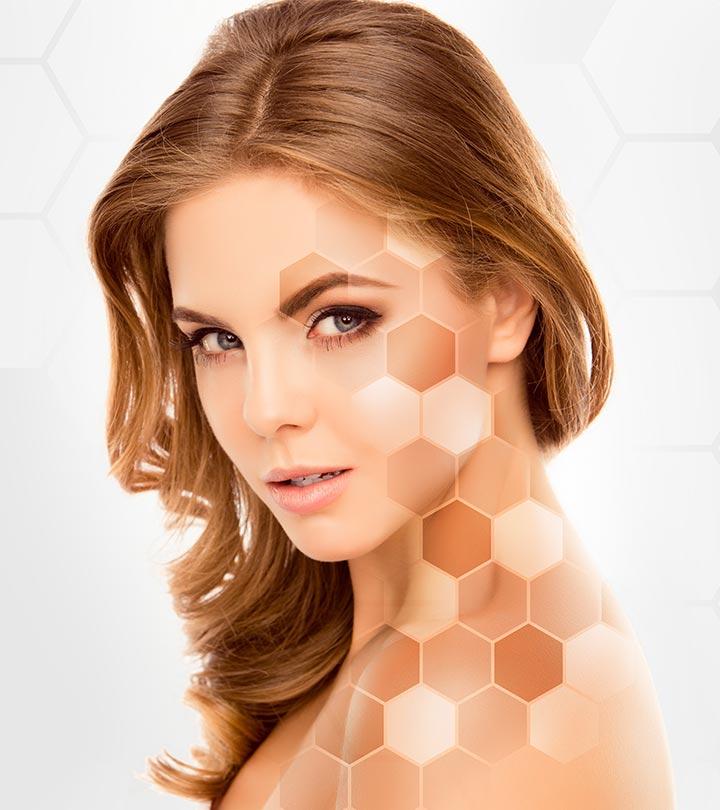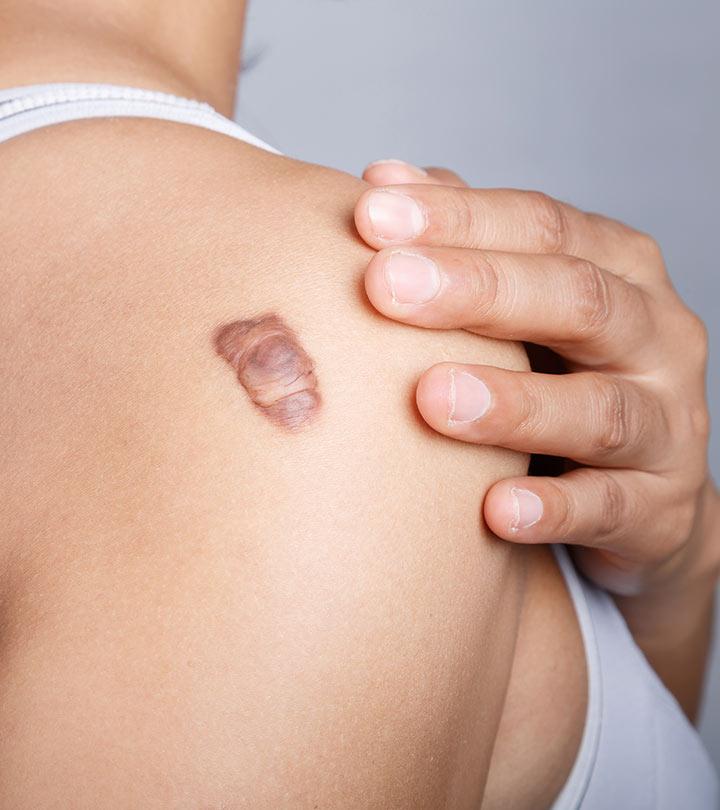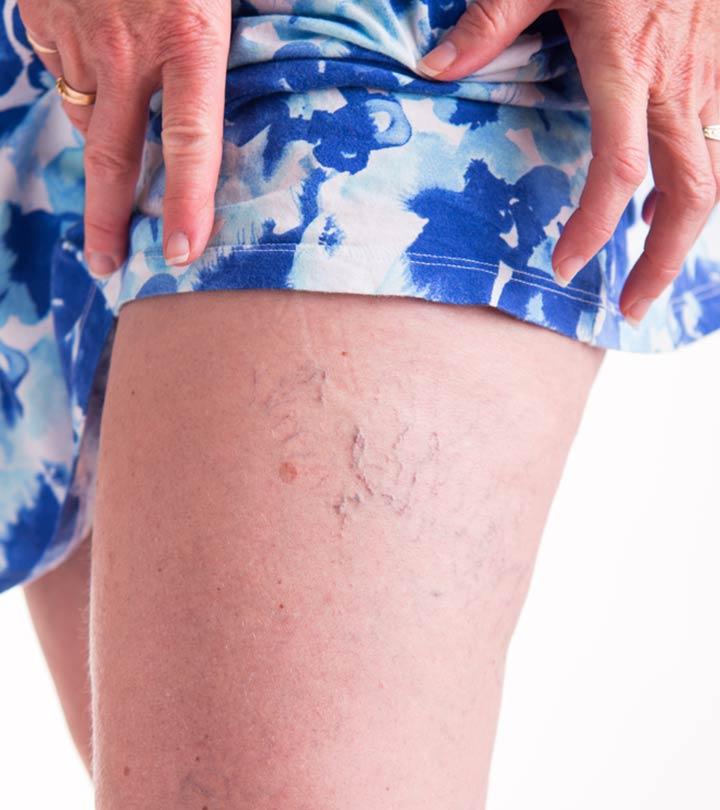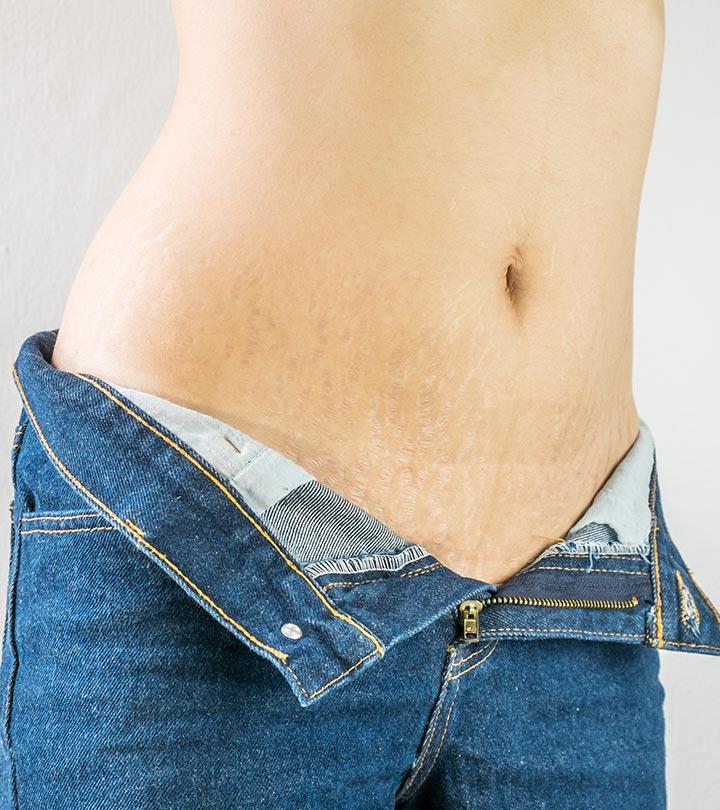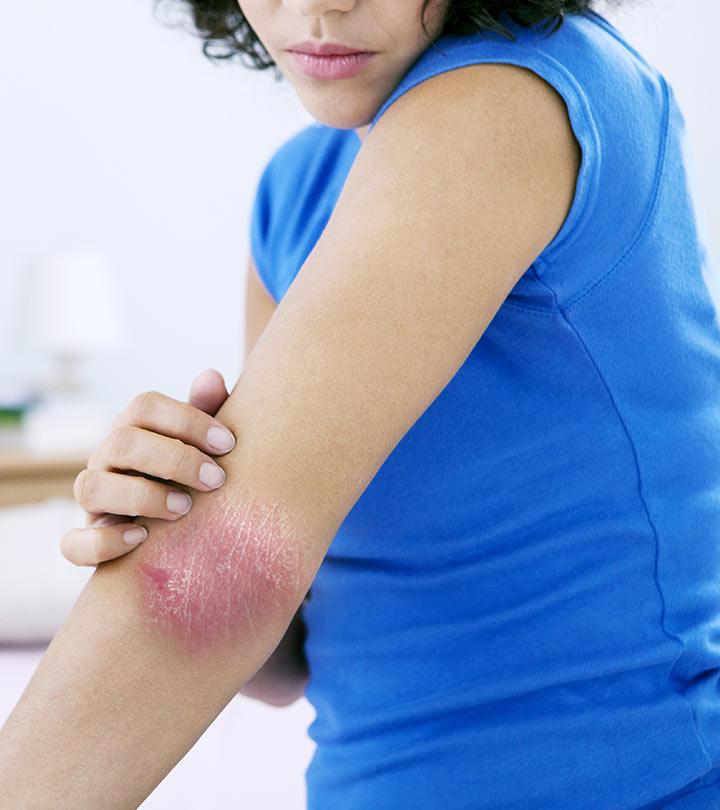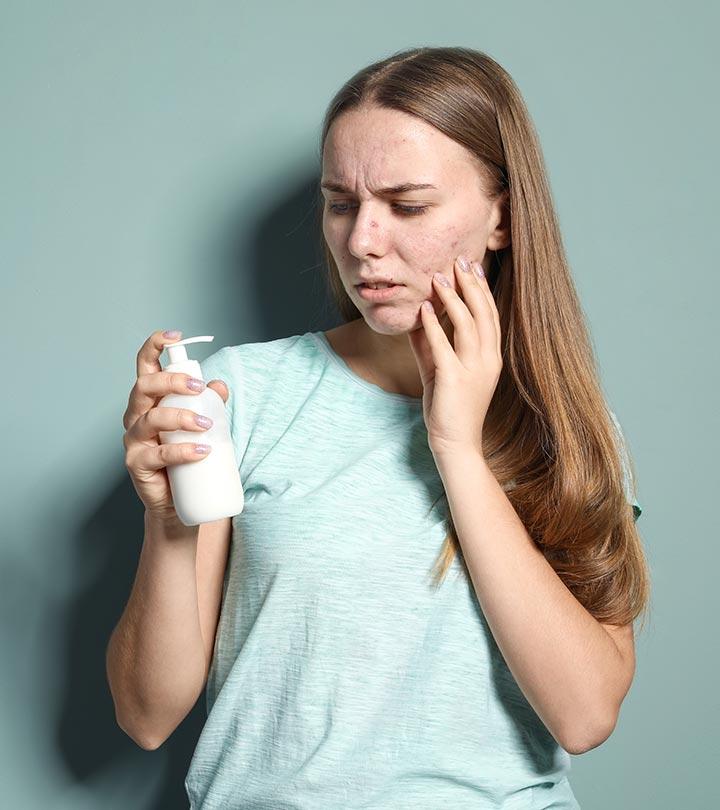Purple Stretch Marks – Causes, Treatment, & Risk Factors
Convenient home remedies to reduce the appearance of these dark stretch marks.

Image: Shutterstock
Stretch marks are harmless. They can occur in purple, red, or white colors. Here, we will talk about purple stretch marks. New stretch marks occur in purple color.
Various reasons lead to the formation of stretch marks. Over 50%-80% of the population have this condition due to various factors (1). However, you can reduce these marks by using home remedies and treatment options. This article discusses purple stretch marks, their causes, and treatments. Continue reading to know more.
In This Article
What Are Purple Stretch Marks? How Do You Get Them?
Stretch marks develop when your skin is stretched beyond its capacity. A lot of factors (discussed later in this article) can stretch your skin, causing rapid and abrupt changes in the elastin and collagen fibers. Both elastin and collagen fibers support the skin to keep it healthy. The abnormal stretching damages these fibers. As your skin tries to heal itself, stretch marks develop.
During the early stages, the stretch mark scars may appear reddish and purple. When collagen and elastin fibers stretch to the point of damage or rupturing and blood vessels dilate, the reddish-purple stretch marks are formed. This is commonly seen in pregnant women and is called striae gravidarum (2). They may also appear pinkish and reddish-brown, depending on your skin tone. Early stretch marks can be a bit itchy and feel slightly raised when you run your fingers on them.
 Did You Know?
Did You Know?Purple stretch marks do not develop everywhere. They develop on specific parts.
Where Do Purple Stretch Marks Appear On The Body?
The most common areas where you get stretch marks are:
- Abdomen
- Hips
- Buttock
- Thighs
- Lower back
- Breasts
- Upper arms
Mae, a lifestyle blogger, recalled memories of her pregnancy stretch marks. She said, “I remember looking in the mirror in horror; my stomach stretched to its limits with a child developing inside, the deep purple stretch marks lining my stomach and thighs, my engorged and drooping breasts also littered with purple lines (i).”
Another blogger shared her Cushing’s disease ordeal in her post. She wrote, “I have purple stretch marks that are thick and purple under my arms, on my breast, knees, and inner thighs. It is now starting to sting when they touch (my thighs) (ii).”
Early stretch marks are easier to treat than late stretch marks (also called white stretch marks). This is because early stretch marks respond to treatment. Although you cannot erase them completely, you can improve their appearance and prevent the severity of the marks.
How To Treat Purple Stretch Marks
1. Microneedling
Microneeding may help minimize early stretch marks. In a study, 16 Korean women underwent three treatments at intervals of four weeks. Seven patients showed excellent improvement (43.8%), while the remaining nine patients showed a minimum to moderate improvement. No significant side effect was reported, except for erythemai A skin reaction triggered by an infection or underlying disease that can cause localized or widespread redness of the skin. , mild pain, and spotty bleeding (3).
2. Retinoids
Tretinoin (Retin-A) is a prescription medication and a form of vitamin A. It may help reduce the appearance of early stretch marks (4). However, it may cause redness, skin irritation, and peeling. Also, avoid using Tretinoin if you are pregnant.
3. Chemical Peeling
Chemical peels are applied to your skin to remove the topmost layer and dead skin cells. This can make the skin smooth. Doctors may also use chemical peels to minimize the appearance of stretch marks. However, you may need multiple sessions.
4. Laser Therapy
Laser therapy is an effective way to improve the appearance of new stretch marks. In a small study, a 585-nm pulsed dye laser with a 10-mm spot improved the appearance of stretch marks (5). In another study, a1064-nm long-pulsed Nd: YAG laser improved immature stretch marks (6).
5. Radiofrequency
This procedure uses radiofrequency energy to stimulate collagen production and improve the appearance of stretch marks. A handheld device emitting radiofrequency energy is applied to the affected area. The energy penetrates the skin’s outer layers and heats the underlying tissues. This leads to instant collagen denaturation, followed by the body’s natural process of producing new collagen. This results in skin tightening and increased elasticity over time, which may help reduce the appearance of stretch marks (7).
6. Ultrasound
Ultrasound waves are targeted into the skin’s deeper layers, encouraging the natural growth of collagen and elastin fibers (8). This may help improve stretch marks.
 Did You Know?
Did You Know?People often use natural and home remedies for treating stretch marks. But do they work? Find out in the next section.
Home Remedies For Purple Stretch Marks: Do They Work?
There is no science-backed evidence that states that home remedies can help eliminate stretch marks. Topical remedies may have mild effects. Also, it is not yet clear if the ingredients in topical creams and ointments have any specific effect.
A study found that the moisturizing effect of the creams and ointments might be the reason for the improvement in stretch marks (9). Hence, the best you can do is keep your skin well moisturized. You may use plant oils for this purpose.
The following plant oils may help keep the skin moisturized:
- Almond oil
- Coconut oil
- Sunflower oil
- Grape seed oil
- Argan oil
- Sesame oil
- Avocado oil
- Jojoba oil
- Shea butter
These oils prevent transepidermal water lossi The amount of water that evaporates through the skin’s surface to the external environment due to dry weather or over-exfoliating. from the skin and maintain the integrity of the skin’s natural barrier (10). You can also use hyaluronic acid, which is thought to stimulate the fibroblasts (cells that produce collagen) and keep the skin hydrated (11).
Above all, you have to watch your diet. When you eat healthy food, your skin gets enough nutrients and stays healthy. This can also help you manage your weight and avoid rapid weight gain.
You may also apply hydrating creams and lotions on the marks, but there is no proof that you will get definite results. However, you can use these remedies as a preventive measure to minimize the appearance of stretch marks, especially if you are prone to them. The following factors put you at risk of developing stretch marks.
Who Can Get Purple Stretch Marks: The Risk Factors
You can develop purple stretch marks if:
- You are pregnant.
- You experience sudden weight gain/loss.
- You are a teenager going through puberty.
- You are overweight or obese.
- You are using corticosteroidsi A class of human-made or anti-inflammatory medicine for asthma, allergies, and inflammatory bowel diseases. .
- You are a bodybuilder who is trying to build muscle mass quickly.
- You are dealing with conditions like Cushing’s syndrome and Marfan syndrome.
Is It Possible To Prevent Stretch Marks?
Not always. However, there are a few things you can do to reduce your risk of developing stretch marks:
- Keep your skin moisturized.
- Drink plenty of water to keep yourself hydrated.
- Maintain a healthy weight.
- Follow a balanced diet. Consume fresh fruits and vegetables to ensure your skin and body get the required nutrients.
- If you are pregnant, work with your doctor to maintain a healthy weight and follow a proper diet.
- Exercise regularly so that you can maintain a healthy weight.
Infographic: Methods To Treat Purple Stretch Marks + Their Side Effects
Stretch marks, as we know, are caused when the skin is stretched beyond its capacity. New stretch marks are usually purple and can occur for a number of reasons, including pregnancy, sudden increase or decrease in weight, etc. While they are nothing to fear or be ashamed of, they still may look unsightly. You can go for certain methods to treat these stretch marks. However, be wary of their potential side effects too. Learn more from the infographic below.

Illustration: StyleCraze Design Team
Purple stretch marks respond well to early treatment as they are at an early stage of stretch mark formation. However, they may also appear pinkish or reddish, depending on the skin tone. While it is advisable to keep the area moisturized to minimize the severity of the marks, it is not possible to completely erase them. If the marks bother you, consult a doctor for a prescription topical medication or cosmetic surgery suggestion. You may also opt for chemical peeling and other medical procedures to minimize their appearance.
Frequently Asked Questions
How long do purple stretch marks take to fade?
Purple stretch marks may take six months to a year to fade if they are properly cared for during their early stages.
Do stretch marks become more visible with weight loss?
Yes. The skin stretches due to weight gain or rapid growth and stretch marks become visible when you lose weight.
Are purple stretch marks different from other types of stretch marks, such as white or red ones?
No, purple stretch marks are not different from other types of stretch marks, such as white or red ones. Usually, in the beginning, stretch marks will appear red and later convert to purple depending on severity.
How do genetics play a role in the development of purple stretch marks, and can they be hereditary?
Yes, genetics play a role in the development of purple stretch marks, and they can be hereditary.
Can purple stretch marks cause any physical discomfort or health concerns?
No, purple stretch marks cannot cause any physical discomfort such as pain or health concerns. It does not cause any pain and just looks like marks on the skin.
Can purple stretch marks indicate underlying health issues, such as hormonal imbalances or nutrient deficiencies?
No, purple stretch marks do not indicate underlying health issues, such as hormonal imbalances or nutrient deficiencies. In rare cases, it needs medical attention depending on the severity.
Key Takeaways
- Stretch marks occur when the skin is stretched beyond its capacity, causing damage to elastin and collagen fibers, particularly during rapid changes like pregnancy or quick weight gain/loss.
- The abdomen, hips, buttocks, thighs, lower back, breasts, and upper arms are common areas where purple stretch marks appear.
- Purple stretch marks can be treated effectively in the early stages with various methods, including microneedling, retinoids, chemical peeling, laser therapy, radiofrequency, and ultrasound.
- Maintain a healthy lifestyle with a balanced diet, proper hydration, regular exercise for weight management and avoiding stretch marks.
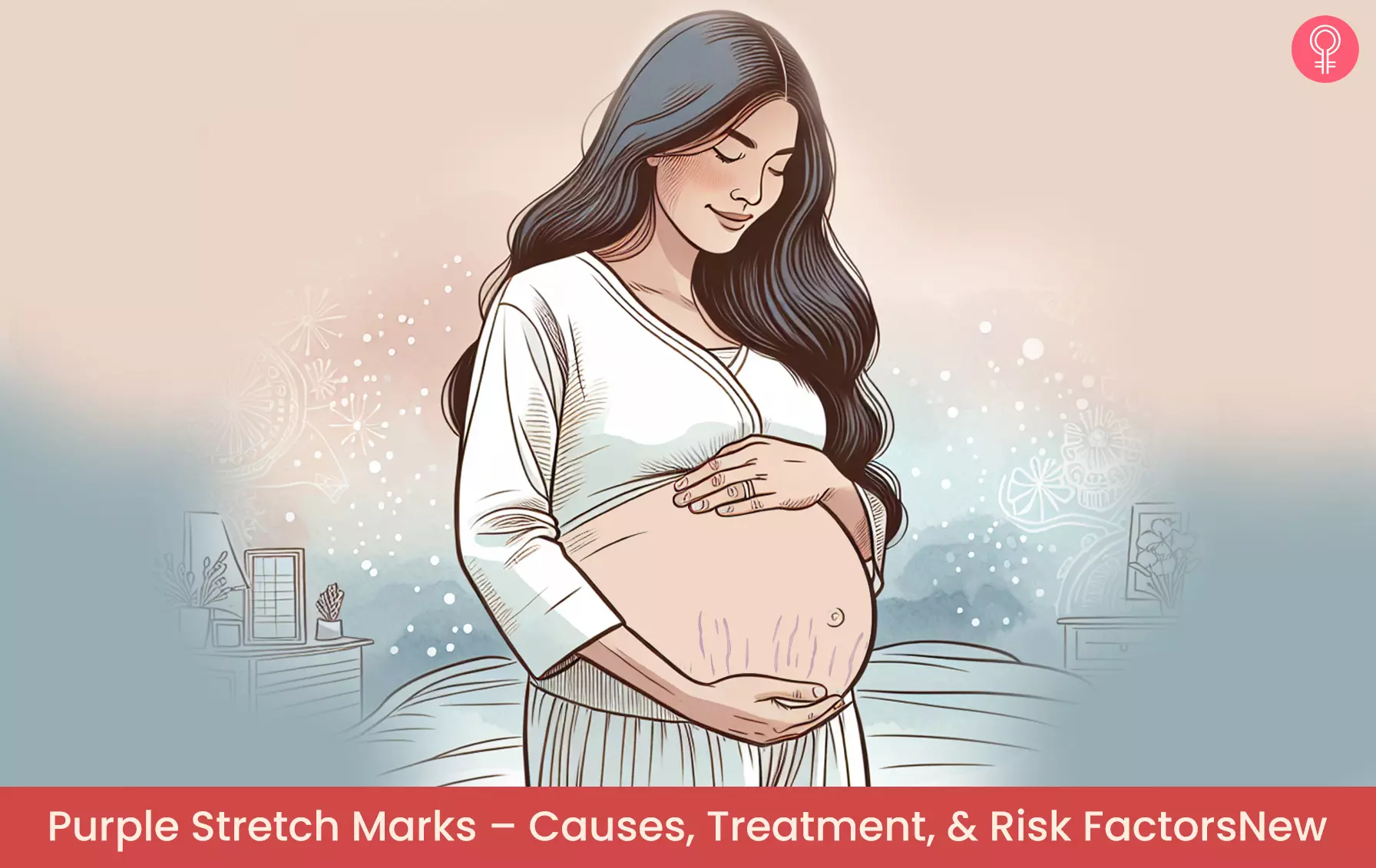
Image: Stable Diffusion/StyleCraze Design Team
References
Articles on StyleCraze are backed by verified information from peer-reviewed and academic research papers, reputed organizations, research institutions, and medical associations to ensure accuracy and relevance. Read our editorial policy to learn more.
- Genome-Wide Association Analysis Implicates Elastic Microfibrils in the Development of Nonsyndromic Striae Distensae, Journal of Investigative Dermatology.
https://www.jidonline.org/article/S0022-202X(15)36019-X/fulltext - Integrative Strategies During Pregnancy, Women’s Health In Complementary And Integrative Medicine, ScienceDirect,
https://www.sciencedirect.com/science/article/pii/B9780443066399500137 - Treatment of striae distensae using needling therapy: a pilot study. Dermatologic Surgery, US National Library of Medicine, National Institutes of Health.
https://pubmed.ncbi.nlm.nih.gov/22913429 - Topical Tretinoin (Retinoic Acid) Improves Early Stretch Marks, Archives of Dermatology, US National Library of Medicine, National Institutes of Health.
https://www.ncbi.nlm.nih.gov/books/NBK436005 - Treatment of Stretch Marks With the 585-nm Flashlamp-Pumped Pulsed Dye Laser, Dermatologic Surgery, US National Library of Medicine, National Institutes of Health.
https://pubmed.ncbi.nlm.nih.gov/8624657 - Stretch Marks: Treatment Using the 1,064-nm Nd:YAG Laser, Dermatologic Surgery, US National Library of Medicine, National Institutes of Health.
https://pubmed.ncbi.nlm.nih.gov/18336578 - Radiofrequency therapy in esthetic dermatology: A review of clinical evidences, Journal of Cosmetic Dermatology, US National Library of Medicine, National Institutes of Health.
https://pubmed.ncbi.nlm.nih.gov/31691477/ - Ultrasound skin tightening, Dermatologic Clinics, US National Library of Medicine, National Institutes of Health.
https://pubmed.ncbi.nlm.nih.gov/24267423/ - A Review of the Effects of Moisturizers on the Appearance of Scars and Striae, International Journal of Cosmetic Science, US National Library of Medicine, National Institutes of Health.
https://pubmed.ncbi.nlm.nih.gov/22994859 - Anti-Inflammatory and Skin Barrier Repair Effects of Topical Application of Some Plant Oils. International Journal of Molecular Sciences, US National Library of Medicine, National Institutes of Health.
https://www.ncbi.nlm.nih.gov/pmc/articles/PMC5796020/ - Topical management of striae distensae (stretch marks): prevention and therapy of striae rubrae and albae, Journal of The European Academy of Dermatology and Venereology, Wiley Online Library.
https://onlinelibrary.wiley.com/doi/full/10.1111/jdv.13223 - Stretch Marks
https://www.ncbi.nlm.nih.gov/books/NBK436005/
Read full bio of Dr. CP Thajudheen
Read full bio of Anjali Sayee
Read full bio of Shiboli Chakraborti





